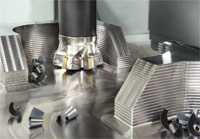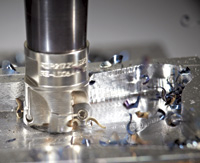by Kip Hanson
Three cutting tool providers offer advice on high feed milling
By now, most shops have at least heard of trochoidal toolpaths. This high efficiency milling (HEM) technique leverages the chip thinning phenomenon together with low radial and high axial depths of cut to greatly increase metal removal rates while also extending tool life. Yet there’s another tool in the chip thinning toolbox, one that uses engagement parameters the exact opposite of trochoidal paths, but produces similar, and in some cases, superior metal removal rates.
All around winner
It’s called high feed milling, or HFM, and Jeremy Corneil, milling product manager for Canada at Iscar Tools Inc., says it’s an extremely productive strategy for a wide range of materials and part geometries. Traditionally used in mould and die operations, HFM uses a much higher radial depth of cut (DOC) than trochoidal (60 per cent or greater engagement is not unusual) and a relatively low axial DOC, mainly relying on the end of the cutting tool for metal removal.
“HFM seems to work on pretty much any material out there. Thanks to the axial chip thinning phenomenon, we are able to increase our chip load per tooth dramatically compared to standard milling tools. This drastically improves metal removal rates while reducing heat retention at the cutting edge, and what heat does remain goes largely into the chip. And because of the shallow lead angle that’s used, cutting forces are directed up into the spindle, creating a lot more stability. It’s really a winner on all materials, from general engineering to aerospace and everything in between. HFM should be everyone’s first mode of attack for rough milling.”
As the name implies, HFM uses extremely high feedrates–for example, Corneil recently worked with a customer machining P20 mould steel and was able to achieve cutting speeds of 700 sfm at 1.5 mm Z axis DOC (0.059 in.) and feedrates of 1.5 mm/tooth (0.059 ipt). Similar results were obtained with 4140 alloy, and again in the duplex steels common in the oil and gas industry.
 Those are impressive cutting parameters. But before you jump online and order a cutter, it’s important to verify that your machine is up to the task. Feedrates this high tax even high horsepower spindles, and profiling operations at this velocity may mean problems with data starvation and look-ahead during cornering.
Those are impressive cutting parameters. But before you jump online and order a cutter, it’s important to verify that your machine is up to the task. Feedrates this high tax even high horsepower spindles, and profiling operations at this velocity may mean problems with data starvation and look-ahead during cornering.
Ease up
“We’re not seeing it in all situations, but certainly with older controllers or when using large face mills, you might have to ease back on the chip load,” Corneil says. “In this situation, it helps to increase the lead angle–going from 17° up to 30° allows you to take a larger depth of cut but still use a fairly aggressive feedrate, say somewhere in the neighborhood of 0.63 to 0.76 mm/tooth (0.025 to 0.030 ipt). That’s why we offer an assortment of insert geometries, grades, and diameters (down to 1 mm) to help our customers achieve their productivity goals.”
Seco Tools is another supplier with its feet firmly in high feed territory. Jay Ball, product manager for solid carbide end mills in the NAFTA region, says HFM works best with complex geometries where a good amount of profiling is needed. “Parts like hip implants, turbine components, and other swept surfaces are great candidates for HFM. If you have a part with a lot of square walls, that’s probably a better application for trochoidal milling.”
The material is just as important. “High feed lends itself well to Inconels, tough stainless steels, and hardened materials,” he says. “Simply put, if it’s a material that doesn’t like to be cut and the part shape warrants it, HFM roughing is often the best way to go.”
All this is nothing new, notes Ball. Mouldmakers have been using HFM to rough large cavities for years, but it wasn’t until trochoidal milling came along that CAM providers began labeling (and in some case patenting) their toolpath strategies. The result has been a synergistic, industry-wide realization that higher performance alternatives to traditional milling exist. And just as software providers have stepped to the plate, so too have cutting tool providers developed countless styles of indexable as well as solid carbide HFM end mills to support those various milling strategies.
“We have a broad selection of indexable cutters, but when you get down in the 20 mm (0.78 in.) and smaller range, we need to consider what is most important to the customer–a lower cost per edge, which is usually achieved with indexable tooling, or higher metal removal rates, which generally means going to solid carbide,” Ball says. “In smaller diameters, depending on part geometry and the material, a solid carbide tool will be a better choice, despite its relatively higher cost.”
 Riding the tornado
Riding the tornado
Ball agrees that the machine tool itself can become a constraint with HFM, especially as tool movements grow smaller. “You can program the machine for 500 inches per minute, but it’s your part feature, the cutting tool, and the machine’s motion control system that determines how fast you are actually moving. And if you can’t achieve the correct feedrate, especially in work hardening materials, tool life will be a killer.”
Yet as Horn USA application and sales engineer Byron Haney explains, the cutters designed for HFM are also good for other operations. “I’ve worked with several customers where they were doing heavy Z axis plunge roughing. One of them was cutting 4140 steel that was heat treated to 38 Rc, and they were able to remove 18 kilos (40 lb) of material in just over 11 minutes using one of our HFM cutters.”
In another example, an equipment manufacturer was attempting to drill 4 in. diameter holes through both sides of 250 mm (10 in.) square steel tubing. After breaking three drills, they asked Haney for help. “I told them to tornado cut (interpolate) the hole with an HFM end mill. It worked great.”
Like his competitors, Haney says it has to be the right application for HFM, and the right machine tool. When in doubt, it’s best to ease back on the depth of cut rather than the feedrate. Dual-contact and 50 taper spindles are preferred over ones with 40 taper and smaller. And for the best tool life, be sure to keep tool runout to a minimum, using a hydraulic toolholder or mechanical milling chuck for the best results. “If you have a rigid machine, a good setup, and can maintain an aggressive feedrate throughout the cut, HFM is tough to beat for tool life and metal removal.” SMT
